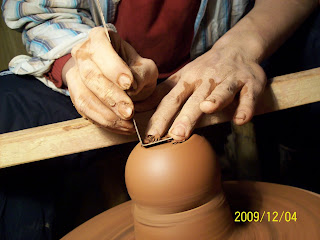

Sifters for sand making
 Small grains of sand to be mixed in cured clay before pot making
Small grains of sand to be mixed in cured clay before pot making Soaking of ground raw clay for 2 years
Soaking of ground raw clay for 2 years
 Drained clay and put away for 10 years of curing before using
Drained clay and put away for 10 years of curing before using Making a pot belly
Making a pot belly

Making a lid
 Rough mode of body and lid
Rough mode of body and lid Redefining body shape/smoothness and footing
Redefining body shape/smoothness and footing

 Smoothing the lid and body together for perfect fitting
Smoothing the lid and body together for perfect fitting
 Added spout and handle rough draft
Added spout and handle rough draft Tools for Ming Zhen - Clear needle, meaning resurfacing refining the tea pot which could take up to a day for only 1 pot without any carving.
Tools for Ming Zhen - Clear needle, meaning resurfacing refining the tea pot which could take up to a day for only 1 pot without any carving.


4 comments:
For what kinds of teas are the sandy brown pots good and why are they so much larger than any of the red ones?
Karen,
It's good for Phoenix Dan Cong oolong in particular, it's also good for Wuyi oolong, dark roast TGY and pu-erh.
What you see in the picture is prior to firing, 20%+ shrinkage after firing. The pot in picture will be 120ml which is rather small compared to Yingxing clay pots.
The brown pots shrink less than the red. It's made to simulate Yixing both in color and size.
Hello,
1- Are they very porous ?
2- Are they appropriate for ripe and raw pu er ?
Thanks in advance.
Annabelle.
Post a Comment